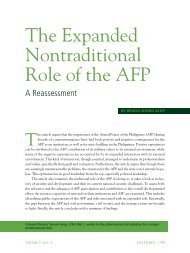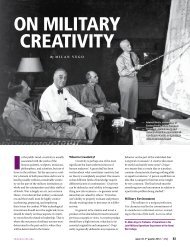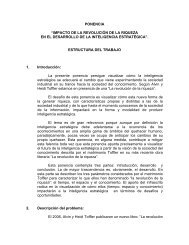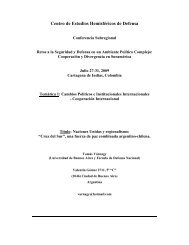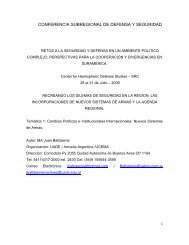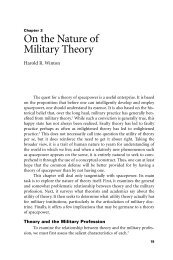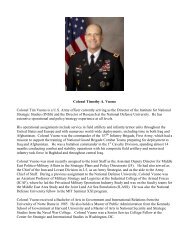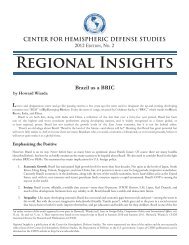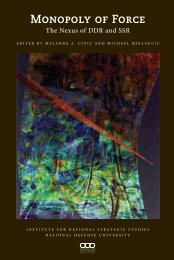In the second half of the 20th century, the US enjoyed pre-eminence ...
In the second half of the 20th century, the US enjoyed pre-eminence ...
In the second half of the 20th century, the US enjoyed pre-eminence ...
Create successful ePaper yourself
Turn your PDF publications into a flip-book with our unique Google optimized e-Paper software.
wide recognition. 30, 31 This is <strong>the</strong> prospecting phase <strong>of</strong> S&T that can lead to later, more evident,<br />
and rapid mining activities 32 and is <strong>the</strong> primary reason for having subject matter experts in DOD<br />
who are among <strong>the</strong> global S&Es working at <strong>the</strong> frontiers. These experts are properly placed and<br />
equipped to inter<strong>pre</strong>t <strong>the</strong> early events.<br />
A subset <strong>of</strong> futures or technology foresight <strong>of</strong> more interest to DOD is <strong>of</strong>ten termed “technology<br />
forecasting,” or TF, as described fur<strong>the</strong>r in Appendix A. The aim <strong>of</strong> TF is to shape <strong>the</strong> DOD<br />
S&T investment portfolio over time. We briefly consider this portfolio in three main parts:<br />
1. S&T areas <strong>of</strong> enduring and perhaps unique importance to DOD<br />
2. Subjects identified as emerging S&T <strong>of</strong> potential and special relevance to DOD<br />
3. Future investment topics <strong>of</strong> high potential for DOD relevance and little investment by<br />
o<strong>the</strong>rs, as yet, where knowledge frontiers could move quickly.<br />
<strong>In</strong> all cases, DOD must understand which S&T areas o<strong>the</strong>r sponsors may cover and make results<br />
available to DOD so its investments can be more focused to meet DOD needs. DOD must<br />
arrange its S&T portfolio to meet all three parts for investing S&T funds as described earlier.<br />
Doing so requires a strategy for employing <strong>the</strong> DOD S&T workforce. The various components<br />
<strong>of</strong> that workforce will have different focuses regarding <strong>the</strong> three parts <strong>of</strong> <strong>the</strong> portfolio. For<br />
example, <strong>the</strong> in-house component has a responsibility across all three parts. There are about<br />
15,000 in-house S&Es funded by S&T dollars. Of <strong>the</strong>se, about 5,000 work in <strong>the</strong> three corporate<br />
laboratories. Because <strong>the</strong> corporate laboratories are best positioned to remain current on<br />
emerging S&T, it is logical that <strong>the</strong>y should have a special focus on parts (2) and (3). The<br />
remaining 10,000 in-house S&Es funded by S&T dollars, along with <strong>the</strong> industrial component,<br />
should focus on parts (1) and (2). The academic component should focus on (3). This is not to<br />
imply that <strong>the</strong> various components <strong>of</strong> <strong>the</strong> DOD S&T workforce should be restricted in <strong>the</strong> areas<br />
where <strong>the</strong>y can contribute. Good ideas should be permitted to arise from any component <strong>of</strong> <strong>the</strong><br />
workforce. Each component should, however, have a clear focus <strong>of</strong> responsibility and activity.<br />
DOD must optimally deploy its finite number <strong>of</strong> S&E assets to balance <strong>the</strong> competing demands<br />
<strong>of</strong> maintaining DOD S&T output and broad awareness. Only in this way can DOD arrange its<br />
portfolio to meet all nine <strong>of</strong> <strong>the</strong> purposes for investing S&T described earlier. Global S&T<br />
awareness is <strong>the</strong> key to success and can be aided through data mining, as discussed in <strong>the</strong><br />
following paragraphs.<br />
Performing S&T data mining to understand <strong>the</strong> frontiers <strong>of</strong> knowledge is not fundamentally new.<br />
If a literature review at <strong>the</strong> beginning <strong>of</strong> a research project is considered a form <strong>of</strong> technical data<br />
mining, as it should be, <strong>the</strong>n researchers have been data mining since <strong>the</strong> dawn <strong>of</strong> scientific<br />
inquiry. It is useful to briefly describe <strong>the</strong> timeless process <strong>of</strong> literature review to see important<br />
elements and limitations. A review starts with a query <strong>of</strong> a particular topic within, for example,<br />
<strong>the</strong> scientific literature. From this, a number <strong>of</strong> potentially relevant papers emerge that <strong>the</strong><br />
researcher carefully examines for content and for <strong>the</strong> list <strong>of</strong> referenced authors with related work.<br />
Most researchers <strong>the</strong>n pursue o<strong>the</strong>r closely related topics suggested by paper’s content and<br />
search for o<strong>the</strong>r publications and <strong>pre</strong>sentations by <strong>the</strong> cited authors <strong>of</strong> interest hoping for more<br />
recent and relevant “hits” on <strong>the</strong> subject(s) <strong>of</strong> interest. From this activity, new ideas and new<br />
30 NDU Defense & Technology Paper Number 17 (2005).<br />
31 Science and Engineering <strong>In</strong>dicators 2010, NSB (2010); see http://www.nsf.gov/nsb/publications/index.jsp.<br />
32 NDU Defense & Technology Paper Number 17 (2005).<br />
23



